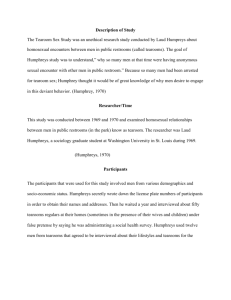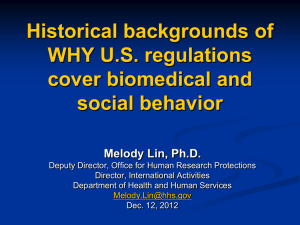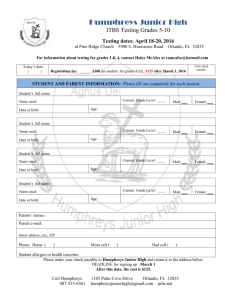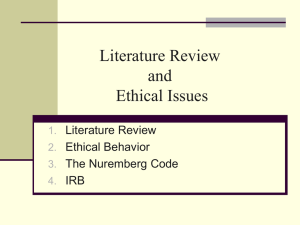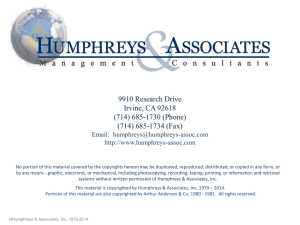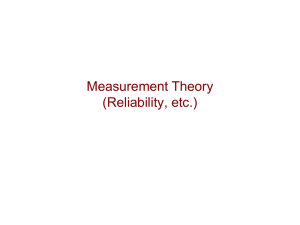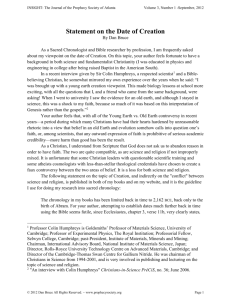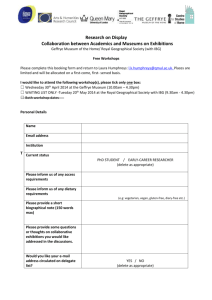Tearoom Trade Group Project
advertisement
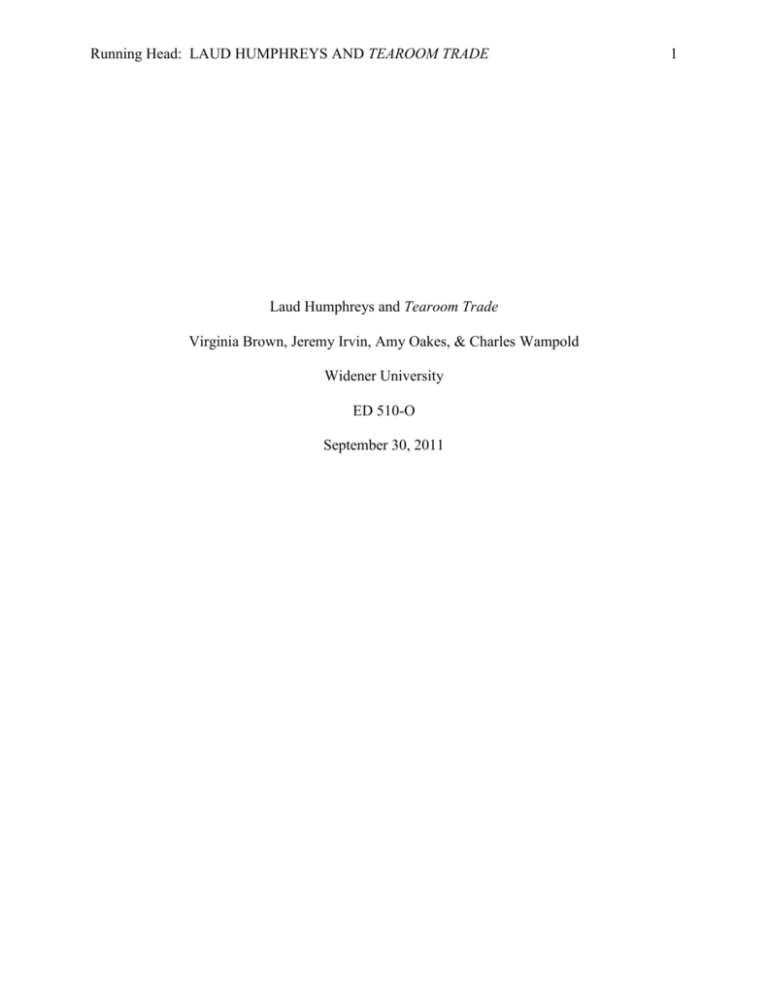
Running Head: LAUD HUMPHREYS AND TEAROOM TRADE Laud Humphreys and Tearoom Trade Virginia Brown, Jeremy Irvin, Amy Oakes, & Charles Wampold Widener University ED 510-O September 30, 2011 1 Running Head: LAUD HUMPHREYS AND TEAROOM TRADE 2 Introduction Laud Humphreys was an American sociologist who is best known for his doctoral dissertation, which was published in 1970 under the title Tearoom Trade: Impersonal sex in public places (hereinafter referred to as “Tearoom Trade”). Tearoom Trade examined the behaviors, customs, and social traits of men who frequent “tearooms,” a euphemism for public restrooms where certain men habitually gather to engage in anonymous acts of sex, usually fellatio (Humphreys, 1970). The subject matter of Tearoom Trade was provocative in its day, but the research methods that Humphreys employed—which included “participatory observation” of non-consenting research subjects and covert (and perhaps illegal) methods of obtaining confidential information—remain controversial to this day (Galliher, Brekhus, & Keys, 2004). Childhood, Education, Marriage and Early Career Humphreys was born October 16, 1930 in Chickasha, Oklahoma and was named Robert Allan Humphreys. His mother died when he was fifteen years old. His father, Ira, was a member of the Oklahoma House of Representatives, where he championed conservative causes such as “blue laws” and racial segregation. Shortly after Ira’s death in 1953, Humphreys discovered that his father had lived his life as a closeted homosexual (Galliher, Brekhus, & Keys, 2004). Humphreys graduated Colorado College in 1952. Eschewing his Methodist upbringing, Humphreys enrolled at Seabury-Western Episcopal Theological Seminary and was ordained an Episcopal priest in 1955 (Galliher, Brekhus, & Keys, 2004). In that same year, he took the name of seventeenth century Anglican Archbishop William Laud, whose dogged antagonism to all things Puritan arguably sparked the English Civil War and induced Parliament to pass a bill of attainder decreeing his execution in 1645 (Laud, William, 1929). Running Head: LAUD HUMPHREYS AND TEAROOM TRADE 3 Humphreys married Tulsa socialite Nancy Margaret Wallace in 1960. They adopted a daughter in 1963 and a son the following year (Galliher, Brekhus, & Keys, 2004). As a clergyman, Humphreys was a social activist and a proponent of the civil rights movement. His liberalism often put him at odds with his conservative congregants, and he was moved from parish to parish. When he was fired from his post at a church in Wichita, Kansas in 1965, Humphreys decided to quit the priesthood and pursue a Ph.D. in sociology at Washington University in St. Louis. As a seminarian, Humphreys had served for two years in a Chicago parish known in the gay community as “queen parish,” and he developed a reputation as an adept counselor to homosexuals (Humphreys, 1975, p.23). He told his friend John Mitchell that he intended to build on this experience in graduate school by undertaking a study of homosexuality. Humphreys bemoaned that virtually all studies of homosexuality to date were based on anonymous questionnaires. Mitchell recalled that “Laud felt it was essential to collect direct observational data, which he early on intended to do” (Galliher, Brekhus, & Keys, 2004, p.18). Researching and Publishing Tearoom Trade and the Ensuing Controversy Humphreys was admitted to Washington University in 1965, and he began his fieldwork for his tearoom study in the summer of that year. The initial fieldwork involved locating tearooms in public parks in nine American cities (Humphreys, 1970). Although Humphreys did not identify the city where most of the data was gathered, it was in fact St. Louis (Galliher, Brekhus, & Keys, 2004). Humphreys noted, “From the beginning, my decision was to continue the practice of field study passing as deviant” (Humphreys, 1975, p. 25). Thus, from 1965 to 1967, Humphreys observed hundreds of sexual acts in tearooms while he pretended to serve as “watchqueen” or lookout. The men Humphreys observed believed him to be one of the participants, but in fact he was making detailed records of each man’s movements within the Running Head: LAUD HUMPHREYS AND TEAROOM TRADE tearoom, the sexual acts in which he engaged and his role in those acts. In more than 100 cases, Humphreys added to a research subject’s dossier the license plate number of the car the subject had driven to the tearoom (p.33). Humphreys credited his dissertation advisor, Lee Rainwater, with the idea of tracing license plates (p.30). Fortunately for Humphreys, “friendly policemen” allowed him unfettered access to the license registers (p. 38). The second phase of Humphreys’ fieldwork involved interviewing his subjects. For reasons unexplained, he was able to enter into a “verbal relationship” with twelve of the men whom he observed in the tearooms. He divulged to these men the research purpose of his presence at the tearooms, and he conducted detailed interviews of this so called “intensive dozen” (Humphreys, 1975, p. 36). In addition, he was able to interview about 50 of the men that had been identified by license plate tracing. To gain access to these men, he posed as a representative of a local research center and told the subjects he was taking a “social health survey” (p. 41). Humphreys reported that none of these men remembered that they had previously encountered Humphreys in the tearoom (p. 42). Some of the study’s conclusions were that more than half the men surveyed were married, and ten percent had a military background (Humphreys, 1970). Humphreys noted that the married subjects were notable for their exaggerated propriety outside the tearoom. Humphreys described these men as “donning the breastplate righteousness” (Humphreys, 1975, p. 135). Humphreys hypothesized that these men assumed the protective shield of “superpropriety” to deflect attention away from their deviance and that these men took pains to being perceived as politically conservative (p. 139). Humphreys successfully defended his dissertation on May 16, 1968, but on June 18, the Chancellor of the University informed Humphreys that it had come to his attention that 4 Running Head: LAUD HUMPHREYS AND TEAROOM TRADE 5 Humphreys had failed to follow University rules and federal laws involving the protection of human subjects and that Humphreys may have violated the criminal laws of Missouri. The Chancellor threatened revocation of Humphreys’ degree. Ultimately, the sociology department secretary took the blame for any research irregularities, and the matter was dropped by the University (Galliher, Brekhus, & Keys, 2004), but that did not end the public controversy. After Tearoom Trade was published in 1970, some sociologists decried Humphreys’ methods as harmful both to the subjects of his study and to the standing of sociology as a field of serious scholarship (e.g., Warwick, 1975). Columnist Nicholas von Hoffman (1970), during the height of the Watergate scandal, argued that invasions of privacy are unacceptable whether perpetrated by a sociologist, J. Edgar Hoover, or an agent of the President. Even some gay activists complained that Tearoom Trade described a small element of the homosexual population, but put the whole community in a bad light, and some complained that Humphreys was a straight man “slumming in gay territory” (Galliher, Brekhus, & Keys, 2004, p. 79). This last criticism proved unfair. At the 1974 American Sociological Association meetings, Humphreys made a dramatic announcement that he was gay, making him America’s first openly gay sociologist (Galliher, Brekhus, & Keys, 2004). Soon thereafter Humphreys and his wife divorced, and he lived the rest of his life as an openly gay man. The Place and The Times The temporal and geographic context of Tearoom Trade partially explains why Humphreys employed his controversial research methods and why the book received such wide attention. Tearoom Trade was researched and written in the era leading to the “Stonewall Riots” of June 1969. Prior to this time, police harassment of homosexuals was rampant and entirely uncontested. In this context, it is not difficult to understand why Humphreys concluded that it Running Head: LAUD HUMPHREYS AND TEAROOM TRADE 6 would be difficult to locate a large sample of men who would be forthcoming about their illegal homosexual behaviors. Further, the timing of the publication of Tearoom Trade, just a few months after Stonewall, clearly enhanced the public’s interest in Humphreys’ dissertation (Galliher, Brekhus, & Keys, 2004). Washington University in the mid-1960s provided an environment uniquely suited to the germination of controversial sexuality research. When Humphreys arrived in 1965, the Washington University sociology department “prided itself on being the leader of graduate sociology programs emphasizing a new and radical tradition” (Galliher, Brekhus, & Keys, 2004). The department was viewed as cutting edge with faculty such as Lee Rainwater, Jules Henry and Alvin Gouldner, who unashamedly combined scholarship and political activism. It was not just the University’s sociology department that was on the frontier of sexology. William Masters was on the University’s medical faculty until 1964, when he and Virginia Johnson opened up their famous clinic across the street from the University. Masters and Johnson’s groundbreaking book Human Sexual Response was published in January of 1966, just months after Humphreys’ arrival at the University. Indeed, Humphreys knew Masters, who read and critiqued Tearoom Trade prior to its publication (Humphreys, 1970). Finally, it is worth noting that Tearoom Trade did not mark the St. Louis Police Department’s first extra-legal intervention on behalf of sex research. In 1955, the President of the St. Louis Police Board, H. Sam Priest, granted immunity from prosecution to any prostitute willing to facilitate William Master’s early research efforts, which involved Masters peering through a peep-hole while the cooperative prostitutes provided their services to customers who were unaware of Master’s spying eye (Maier, 2009). Ethical Violations Humphreys’ research contained various ethical violations. Humphreys did not receive Running Head: LAUD HUMPHREYS AND TEAROOM TRADE 7 informed consent from all of his participants of the study due to the fact that most did not know they were participants. According to the Nuremberg Code: Directives for Human Experimentation, “The voluntary consent of the human subject is absolutely essential” (Cottrell & McKenzie, 2011, p. 96). Humphreys only informed a few of his participants of his true identity and purpose for being at the tearoom. The ethical violation of not having informed consent leads to several other violations such as privacy, use of deception, and publishing results without valid consent of the participants (Cottrell & McKenzie, 2011). He violated the rights of privacy by observing men during a private act without their consent and as well by writing down their license plate numbers and eventually going to their homes. Humphreys participated in the act of active deception by deliberately omitting the true reason for his visit to their homes. He was deceitful as well for obtaining personal information and using it to publish results other than what the participants had believed the purpose to be. Participants did not give their consent for their personal information to be published in his Tearoom Trade research, which therefore constitutes an additional ethical violation. Another violation of ethics would be Humphreys putting his participants in possible danger (Cottrell & McKenzie, 2011). At the time of the study, if somebody found out about the identity of the participants and their same-sex encounters, there was the possibility of their being physically abused. Any research that could put a participant in danger is unethical. As well, at the time, homosexual sex was considered illegal. Laud Humphreys’ participation as “watchqueen” was an illegal activity and it would violate ethics to commit a crime during research. Also, his studies and names of participants could possibly have been subpoenaed because of the illegal activity, which would once again put participants in trouble and danger. Running Head: LAUD HUMPHREYS AND TEAROOM TRADE 8 Influence on Research Ethics The publication of Tearoom Trade caused intense conflict in the sociology department of Washington University. Other members of the department, outraged at the ethical violations, wanted Humphreys’ PhD rescinded (Sieber, n.d.). While the administration ultimately stood by its granting of the degree, publication of Humphreys’ dissertation was stalled for two years. Most sensationally, there was a fistfight between Humphreys and Alvin Gouldner, one of the sociology faculty most vehemently opposed to publication of Tearoom Trade (Goodwin, Horowitz, & Nardi, 1991). The conflict between those who believed the ethical violations to be inexcusable and those who believed that the value of Humphreys’ research outweighed them was passionate, and a large number of faculty left Washington University over it. In 1974 a National Research Act was enacted, creating the National Commission for the Protection of Human Subjects of Biomedical and Behavioral Research. Now, institutions that conduct research on human subjects are required to have an Institutional Review Board, which reviews research proposals to ensure that basic ethical principles are being met, in order to receive federal funding (Weber, 2005). Some of the basic ethical principles the commission agreed upon were: - beneficence: making efforts to avoid harm to human research subjects - informed consent: giving the research participants the option to refrain from participating in the light of full information about risks and purposes of the project (Brady et al., 1974). The Tearoom Trade would have been judged in violation of both of these principles, if the commission had existed at the time of its publication. Conclusion Upon the time of Laud Humphreys seminal dissertation being published, and still today, Running Head: LAUD HUMPHREYS AND TEAROOM TRADE his research has had the power to polarize people’s personal views around whether his research was ethical or not. Having said that, no matter what side of the controversy a person falls into, the fact of the matter cannot be disputed that Laud Humphreys has had a great impact on the history of ethical research practices as well as the advancement of sexology research. 9 Running Head: LAUD HUMPHREYS AND TEAROOM TRADE 10 References Brady, J. V., Cooke, R. E., Height, D. I., Jonson, A. R., King, P., Lebacqz, k., … Turtle, R. H. (1974, July 12). The Belmont Report: Ethical principles and guidelines for the protection of human subjects of research. Retrieved from http://ohsr.od.nih.gov/guidelines/belmont.html#gob1 Cottrell, R. R. & McKenzie, J. F. (2011). Health promotion and education research methods using the five-chapter thesis/dissertation model (2nd Ed.). Salisbury, MA: Jones & Bartlett. Galliher, J. F., Brekhus, W. H., and Keys, D. P. (2004). Laud Humphreys: Prophet of homosexuality and sociology. Madison, WI: University of Wisconsin Press. Goodwin, G. A., Horowitz, I., & Nardi, P. M. (1991). Laud Humphreys: a pioneer in the practice of social science. Sociological Inquiry, 61(2), 139-147. Humphreys, L. (1970). Tearoom Trade: Impersonal sex in public places. Chicago: Aldine. Humphreys, L. (1972). Out of the Closets: The sociology of homosexual liberation. Englewood Cliffs, NJ: Prentice-Hall. Humphreys, L. (1975). Tearoom Trade: Impersonal sex in public places. Enlarged edition with a retrospect on ethical issues. New Brunswick, NJ: AldineTransaction. Laud, William. (1929). In Encyclopaedia Britannica (14th ed., Vol. 13, pp. 764-765). New York: Encyclopaedia Britannica, Inc. Maier, T. (2009). Masters of Sex: The life and times of William Masters and Virginia Johnson, the couple who taught America how to love. New York: Basic Books. Masters, W. H., and Johnson, V. E. (1966). Human Sexual Response. Boston: Little, Brown and Co. Running Head: LAUD HUMPHREYS AND TEAROOM TRADE Sieber, J. (n.d.) Laud Humphreys and the tearoom sex study. Retrieved from http://web.missouri.edu/~bondesonw/Laud.html Von Hoffman, N. (1970, January 30). Sociological snoopers. The Washington Post, p. B1. Warwick, D. P. (1975, February). Social scientists ought to stop lying. Psychology Today, 38, 105-106. Weber State University. (2005, August 23). Instituional review board (irb) history. Retrieved from http://www.weber.edu/IRB/irb_history.html 11

